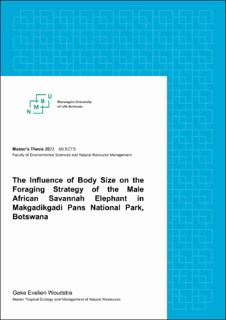| dc.description.abstract | Differences in feeding behaviour and species selection, due to the difference in body size, between the sexes for the African savannah elephants (Loxodonta africana) is well documented. However, there are also substantial body size differences within male elephants due to their two significant growth periods and continues growth. Therefore, the main objective was to explore how body size influences the foraging strategy between male elephants. Differences in feeding behaviour, selection of woody plant species and feeding patch choices of male African savannah elephants, according to sex and physical condition were examined during the dry season in Makgadikgadi Pans National Park in Botswana. Behavioural observations of feeding bouts were used to investigate the duration of the feeding bout, number of mouthfuls, the part of plant species eaten, foraging intensity index, feeding height and plant height. Vegetation sampling, using both a feeding plot and a control plot, where used to determine the woody species selection and the feeding patch choice. The youngest elephants (10-20 years) exhibited more selective feeding behaviour than older elephants (21-25 and 26+ years), as indicated by the lower foraging intensity index score, selection of smaller branches, browsing for a shorter amount of time, a lower number of mouthfuls, and a higher bite rate. The oldest males (26+ years) had the least diverse diet of woody plant species, with a small number of species dominating the diet, whereas the elephants 21-25 years of age had the widest range in their diet in term of woody plant species and a positive selection for Philenoptera violacea and Dichrostachys cinerea. The oldest elephants (26+ years) selected patches that offered the highest density of edible species, whereas the younger elephants (10-20 and 21-25 years) focused on patches with the largest number of preferred species and with a high richness of woody species present. These results suggest that body size is a vital factor in understanding dietary differences within male African elephants in terms of feeding behaviour, selection of woody plant species as well as feeding patch choices. This is consistent with the foraging hypothesis, which states that a larger body size enables consumption and digestion of higher quantities of low-quality forage while still obtaining sufficient nutritional benefits to match their energy demands. | |
